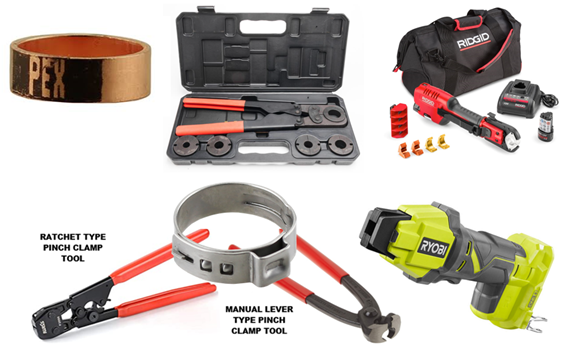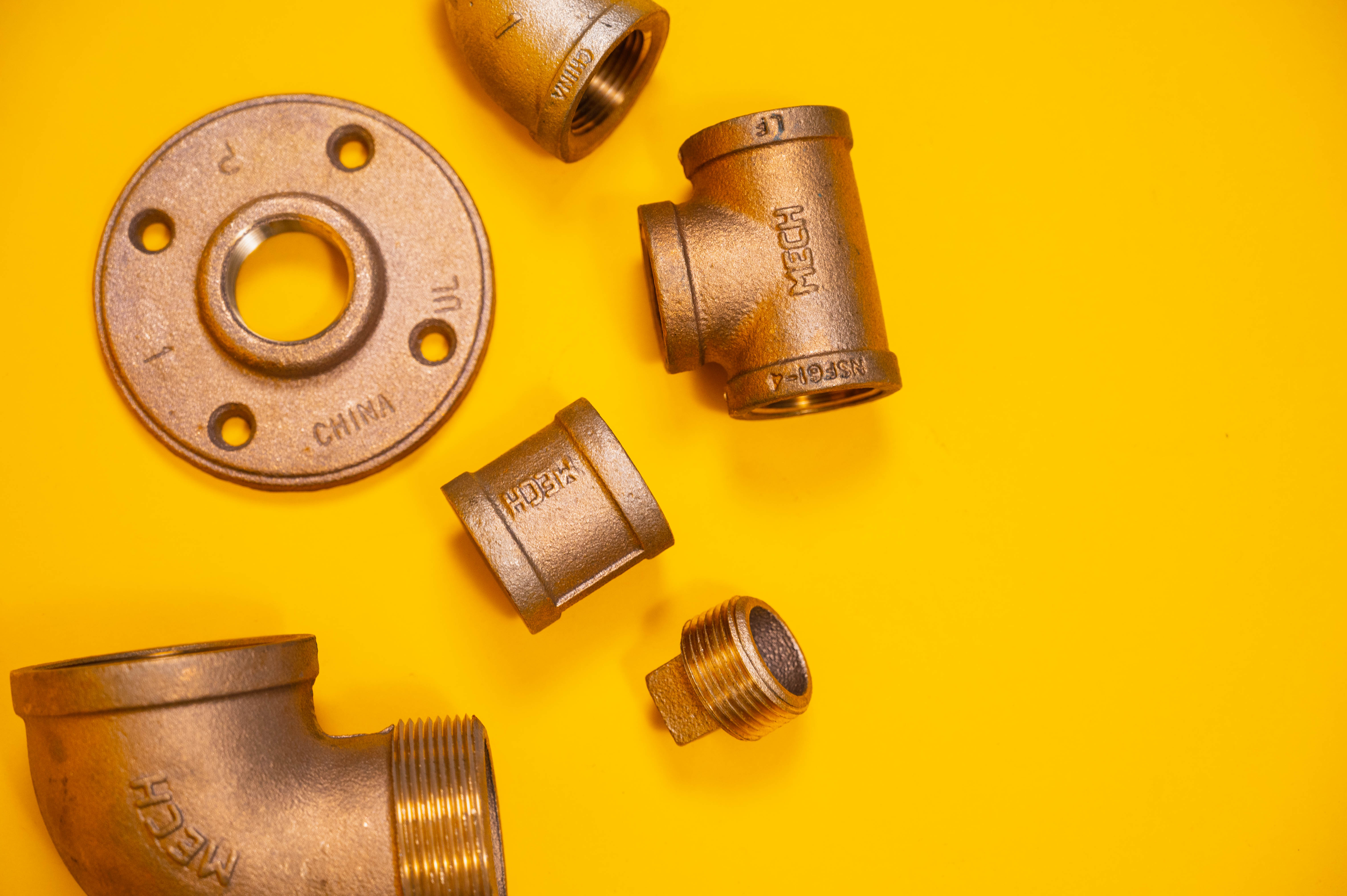It doesn’t matter if you’re a homeowner making a repair or you’re a worker entering the plumbing trade for the first time: it’s an important skill to know how to identify the PEX plumbing you have on hand, what factors to consider when installing it, and how you know that you’re choosing all the best components to set you up for success.
While the nuances between different materials and products can seem insignificant to anyone who doesn’t know, choosing mismatched or inadequate components in a plumbing system can be catastrophic for countless reasons.
In this guide, we’ll cover all the different ways to identify the type and size of PEX tubing you’re using, comparing the different fitting options available on the market, installation methods, and a few other tips and tricks you should know.
1. Identifying the different types of PEX tubing
There are three types of PEX tubing available for plumbers: PEX A, PEX B, and PEX C. The primary differences between these three materials are the methods that the manufacturer uses in order to create them. PEX, of course, is the industry term for cross-linked polyethylene. The method in which a manufacturer performs the cross linking is what denotes what type of PEX (A, B, or C) it is.
The differences between the three are not necessarily that of grade or performance. PEX A is not inherently better than PEX C. The different types of PEX help plumbers determine what form of fitting to use and what characteristics the tube will have.
In general, the type of PEX a plumber uses primarily comes down to personal preference. Because all three types of PEX tubing must meet ASTM F876 and NSF/ANSI/CAN 61 standards, plumbers can rest assured that their choice will be up to code. You will see small variations in density, burst pressure levels and bend radiuses between PEX pipe types, but they’re negligible.

Without delving too far into highly technical information about the processes used in making these different types of PEX, here is a quick break down of what the most notable characteristics of each type are, and why you might want to choose one over the other.
Pex A
- Highest flexibility
- Has “memory” which means it shrinks back to size
- Has the greatest “kink” resistance
- Must be used when making cold-expansion (CEP) connections
- Most versatile, many ways to make a joint (cold expansion, crimp ring, pinch clamp, push-fit, compression or twist & lock)
Pex B
- Typically used for crimp type fittings as it is the most economical option
- Variety of ways to make a joint (crimp ring, pinch clamp, push-fit, compression or twist & lock)
- More rigid than PEX A & PEX C
- Lower “kink” resistance
Pex C
- Uses the same connection methods as PEX B joint (crimp ring, pinch clamp, push-fit, compression or twist & lock)
- Least common type of PEX piping in use
- Slightly more rigid than PEX A, some brands have been prone to development of cracks
- Lower “kink” resistance than PEX A
If you’re starting from scratch on a new plumbing project, you can choose what type of PEX you want to use based on some of the above benefits. Of course, what your local plumbing supply store carries will also impact your decision.
If you’re making a repair to an existing PEX system, you’ll want to identify what type of PEX is currently being used so you can match it. Simply look at a section of plumbing that is intact, particularly around any joints. If they are cold expansion fittings, you know PEX A was used by the plastic PEX-A Ring / Sleeve. If they are fittings of nearly any other type, you’ll know it’s most likely PEX B or possibly PEX C, and you can buy accordingly.

2. How to determine the size of your PEX piping
Determining the size of your PEX is fairly easy, it is printed along the side of the PEX pipe.
In the event the printing has faded, no worries. The outside diameter can be measured using a vernier caliper.


While PEX ranges from 3/8” to 1”, the most common sizes you’ll see in residential applications are 1/2” and 3/4” while 1” is often used for main feed lines. In general, we recommend matching what already exists in your system.
Note about changing diameters:
In most applications, it may be easier sticking with the same diameter PEX pipe previously used in your system. However, if you are experiencing flow issues or poor pressure it may be beneficial to increase the diameter. One should be aware that PEX piping has a smaller inside diameter than copper pipe of the same nominal size.
3. Comparing the types of Pex connections available
Now that you’ve identified the type of PEX you’re using, we can begin examining what type of fitting might make the most sense for your needs.
PEX A - Cold Expansion Fitting
If you’re using PEX A piping, Cold Expansion PEX (CEP) fittings are the most common type of fitting that you’ll see being used and are exclusive to PEX A. The biggest benefit is that these fittings are the same inside diameter as the pipe and do not reduce flow to the same extent as crimp fittings.

PEX B & PEX C - Crimp & Pinch Fittings
By all means one of the most popular and economic options within PEX B systems is a copper crimp ring or S.S. pinch clamp. These two technologies are similar in that a metal fastener is attached over the barbs of the fitting with the PEX tube in between. The ring or clamp is then secured by a dedicated tool to ensure a proper fit.

Push Fit / Push to Connect Fittings
The simplest and easiest connection to make, no special tools are required. A Push Fit fitting is pressed onto the end of a PEX Pipe and the connection is complete. Although these fittings are easy to install and great for repairs the cost tends to be prohibitive for new installations, as they are sometimes 5-10x more expensive than their crimp ring or pinch clamp counterparts. There is also debate within the plumbing community about the permanence and trustworthiness of some of these fittings in enclosed locations (behind walls, etc.).

Compression Fittings
Especially in cases where a PEX fitting is being married to an alternate form of pipe with copper tube size (CTS) copper, CPVC and some types of tubing. A compression fitting may be an appropriate choice. A brass sleeve and nut are installed over the end of the PEX pipe or CTS tubing, and then the pipe is inserted into the fitting. When the brass nut is tightened the sleeve creates a compression seal.

Twist & Lock Fittings
Twist lock fittings are not a very common use in pex applications, but can be helpful in certain situations. Many Twist Lock fittings are used on smaller diameter plastic pipe, but can be used on pex as well.

Press Fittings
Perhaps the least common type of PEX fitting, press fittings are a single piece that includes both fitting and fastener in one. The PEX pipe is attached onto the barb of the fitting and under the sleeve. A specialized tool is required to complete the press connection. A set of dedicated tooling is required if working with different diameters of PEX.

Is there a right or wrong option? In most cases, no. But there is certainly better or worse options, depending on what your specific needs are in your plumbing system.
4. Comparing the materials of various fittings
PEX fittings are most commonly made up of one of three different types of materials: Plastics, Brasses, or Stainless Steel. Alternatively, a push fit fitting uses a combination of these materials. As you can imagine, there are pros and cons to each choice that we’ll briefly outline below.
Plastic
If cost is your number one priority, it’s impossible to beat plastic fittings in a PEX system. These fittings are also incredibly resistant to corrosion.
The trade-off is that crimp type PEX they have a thicker wall than metal fittings, since the fitting goes inside of the PEX pipe, water flow can be severely restricted. A handful of plastic fittings won’t make a significant difference, but over the course of an entire system, the loss in flow and or pressure can really add up.
Note that plastic Cold Expansion PEX (CEP) fittings have similar inside diameters to metal cold expansion PEX fittings and do not negatively affect the flow.
Brass
Metal crimp fittings, such as brass, tackle the problem of thickness head-on. Because metal is significantly stronger than plastic, a thinner metal fitting can be utilized and still exceed the strength of a plastic fitting. How much does strength matter? This will of course vary depending on your specific use case, but for safeguarding against things like water hammer (shockwaves sent through your plumbing system when a valve is shut off too quickly) or manufacturing defects, metal is the superior choice.
The biggest downfall with brass is its susceptibility to corrosion. Especially because PEX itself does not corrode (in general), there’s only one place that the corrosion will target: your fittings. Brass is susceptible to dezincification, and in certain water condition it has been known to cause serious problems resulting in property damage due to leaking or cracked fittings. How likely are you to spring a leak? That entirely depends on the quality of your water and what is in it. There are opportunities to send a sample of your water off to a lab to be tested, but for the average person, this is more involved than they care to get.
Stainless Steel
When you want a product that has the corrosion-resistance of plastic and strength that is superior to brass, stainless steel fittings are by all means the best option available. With strength that’s been tested to twice the force of brass, a stainless steel fitting really is the best of both worlds, there’s no other fitting on the market that can match it feature-for-feature.
The limiting factor to stainless steel fittings (if you could call it that) is that Cold expansion fittings are not available, they are only available in Crimp PEX fittings (ASTM-F1807) fastened by copper crimp rings or SS pinch clamps. Boshart Industries is the first-to-market with Stainless Steel also meaning you can only find these products with us. If you’re interested in using stainless steel fittings but can’t find a distributor near you who sells them, get in touch with us and we will get you connected as soon as possible.
For more information on Stainless Steel Pex Fittings, Click Here
5. Tools to make these connections
If you’re completely new to plumbing, the investment in the tools to start with any one of these systems is another factor to consider. If you’re only doing a small, one-off job or repair, manual tools or a fitting system that does not require special tools is likely your best option. It probably doesn’t make sense to invest in a complete power tool system that is going to break the bank. But, if you’re planning on doing routine plumbing, it might benefit you to look at specialized tools that will reduce installation time and are easier to use.
Cold Expansion Connections
While there are manually operated hand tools that can be used for cold expansion PEX plumbing, the most common type for most plumbers are battery operated hand tools. For many plumbers, the investment in this power tool pays back quickly in saved time making a high number of connections every day.

Crimp Ring Connections / Pinch Clamp Connections
While there are power tools that can make crimp ring connections, it is still more common to find manually operated hand tools in a plumber’s toolbox. A crimp ring requires the jaws of the tool to go over the PEX tube and around the ring for clamping, but a pinch clamp only requires the ends of the jaw be able to access the small ear on the clamp. In instances where you might be operating in a confined space, the pinch clamp can sometimes make the job easier.

Push Fit / Push to Connect Fittings
Requiring no special tools whatsoever, these connections can be made entirely by hand. While you might be saving the cost of investing in a particular tool to use a push-fit fitting, this cost is quickly negated by the higher cost of push-fit fitting, especially if you are installing numerous fittings.
Compression Connections
Compression fittings do not require any special tools beyond two wrenches. Like Push-Fit fittings you might be saving the cost of investing in tools, this cost is quickly negated by the higher cost of compression fittings, especially if you are installing numerous fittings.
Press Connections
Require a special tool to make the connection. In addition to the higher cost of these fittings, the additional cost of an entire set tooling that a plumber must invest in to clamp the different diameters of Press PEX fittings make this system less desirable to many. As opposed to pinch clamp tools where one tool works on multiple size of clamps. Whether this means the cost is thus enabling or prohibitive is a matter of interpretation.

In Conclusion:
Ultimately, it’s up to you to determine what choice makes the most sense for your unique situation. Often, it is a balance between choosing a fitting that will work with your system, that is economical for the size of budget you have for the job, and the type of investment you want to make in the tools to get the job done.
Soldering with copper piping is long on its way out as the preferred method of plumbing, due to its higher cost. PEX plumbing has made making installation easier and more economical. No matter what you go with, it’s hard to make a wrong choice.
Have further questions about this subject?
 Head over to Boshart's Knowledge Base: technical product information, guidelines, and more.
Head over to Boshart's Knowledge Base: technical product information, guidelines, and more.


.png)


SHARE